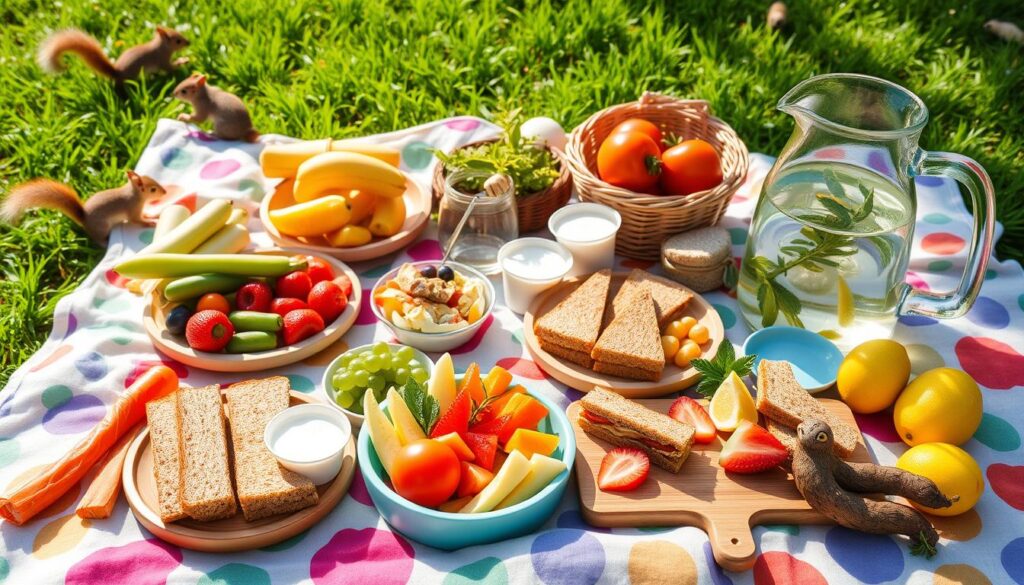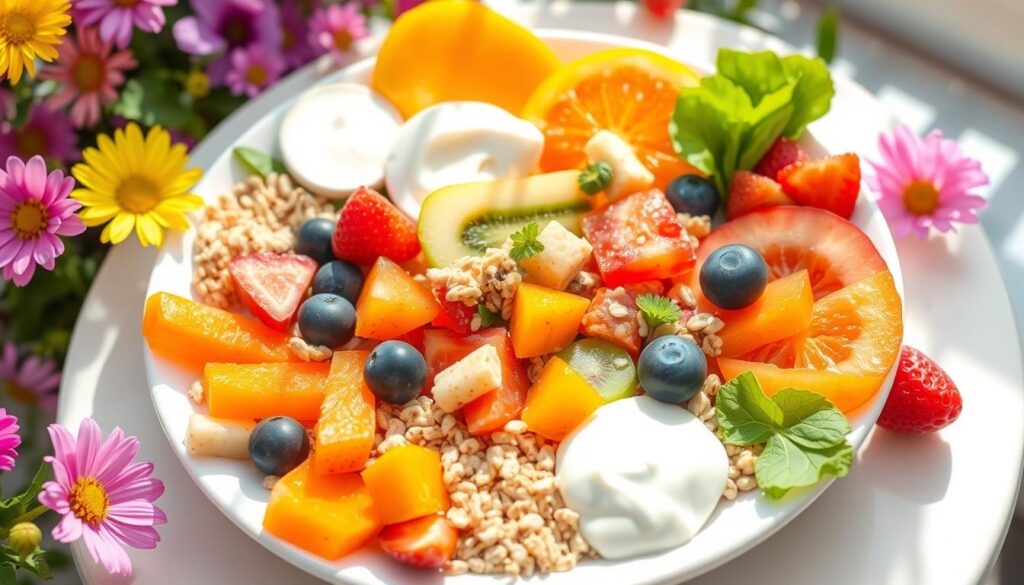Are you unknowingly setting your child on a path to lifelong unhealthy eating habits? The choices you make as a parent significantly influence your kids’ nutrition. In today’s fast-paced world, establishing a foundation of healthy eating for children is more critical than ever. This article aims to provide effective tips and tricks for promoting balanced meals for kids.
By introducing a variety of nutritious foods, from all food groups while minimizing added sugars and unhealthy fats, you can foster autonomy in your child’s food choices. Understanding the current trends in kids’ nutrition will empower you to make informed decisions that shape their eating habits for a healthier future. Discover more on how to cultivate these beneficial practices for your family in the following sections or visit this resource.
Key Takeaways
- Parents play a critical role in shaping children’s food preferences and habits.
- Involving kids in meal planning and cooking encourages healthier choices.
- Strive for balanced meals by incorporating various food groups for optimal nutrition.
- Limit sugary drinks in favor of water and milk to promote better hydration.
- Healthy eating can prevent chronic diseases and boost mental well-being in children.
- Food choices are influenced by exposure; repeated introduction of new foods is vital.
- Modeling healthy eating behaviors as parents significantly impacts children’s choices.
Importance of Healthy Eating for Children
Healthy eating is key for kids’ growth, both in body and mind. It helps them have more energy and feel better. It also helps them stay at a healthy weight and avoid obesity and mental health problems. Teaching your child about good nutrition is a big step towards their well-being.
Benefits of a Nutritional Diet
Good nutrition does more than just fill a belly. Kids who eat well tend to remember things better and have steady energy. For example, eating breakfast helps teens stay slim and do better in school. Also, eating complex carbs gives more energy than simple carbs, which can make you feel tired.
Long-term Health Impacts
Starting kids on healthy foods early can prevent big health problems later. Kids who eat well are less likely to get diseases like diabetes and heart disease. A balanced diet also fights off anxiety and depression, which can come from bad food choices. With most packaged foods full of sugar, choosing wisely is key to a healthy future for your kids.
| Health Aspect | Impact of Healthy Eating |
|---|---|
| Physical Development | Supports growth and prevents obesity |
| Mental Health | Reduces the risk of anxiety and depression |
| Academic Performance | Enhances memory and cognitive function |
| Energy Levels | Maintains stable energy throughout the day |
| Chronic Disease Prevention | Lowers risks of long-term illnesses |
Healthy Eating for Children: Essential Nutritional Needs
It’s important to know what kids need to eat for their health. They should eat a variety of foods to grow well. Each food group gives them the nutrients they need.
Understanding Food Groups
There are five main food groups for a healthy diet:
- Fruits
- Vegetables
- Grains
- Protein foods
- Dairy or fortified soy alternatives
It’s key to include many foods from these groups. Each group helps in different ways, like giving vitamins and helping bones and muscles.
Recommended Daily Servings
The amount of food kids need changes with age and how active they are. Here’s a guide for daily servings:
| Age Group | Fruit (servings) | Vegetables (servings) | Grains (servings) | Protein (servings) | Dairy (servings) |
|---|---|---|---|---|---|
| 2-3 years | 1 | 2.5 | 4 | 1 | 1.5 |
| 4-8 years | 1.5 | 4.5 | 4 | 1.5 | 1.5-2 |
| 9-11 years | 2 | 5 | 4-5 | 2.5 | 2.5-3 |
| 12-13 years | 2 | 5-5.5 | 5-6 | 2.5 | 3.5 |
| 14-18 years | 2 | 5-5.5 | 7 | 2.5 | 3.5 |
Encourage kids to try different foods from these groups. This helps them get the nutrients they need. Also, limit foods with too much sugar, fat, and salt for a balanced diet.
Building Balanced Meals for Kids
Creating balanced meals for kids is all about mixing different food groups. Make sure their diet is full of colorful fruits and veggies. This is key for getting the nutrients they need. Try to fill half of their plate with these foods.
Adding whole grains and lean proteins gives them the energy they need to grow. These foods are essential for their development.
Incorporating Fruits and Vegetables
Adding fruits and veggies to meals is a big health boost for kids. A colorful plate is not only fun to look at but also packed with nutrients. Aim for five servings a day.
Make these foods fun and interesting to eat. Try different ways to serve them. And remember, whole fruits are better than fruit juice.
Protein Sources and Whole Grains
Proteins are important for muscle growth in kids. Choose lean meats like chicken and fish, and plant-based options like beans. These go well with whole grains.
Whole grains like brown rice and whole wheat bread are key for balanced meals. They give kids energy and help manage blood sugar. They’re better than refined grains for kids’ health.
| Food Group | Recommended Servings | Examples |
|---|---|---|
| Fruits | 2-4 servings | Apples, bananas, berries |
| Vegetables | 3-5 servings | Carrots, broccoli, spinach |
| Whole Grains | 3-5 servings | Brown rice, quinoa, whole wheat bread |
| Protein Sources | 2-3 servings | Chicken, fish, legumes |
| Dairy | 2-3 servings | Low-fat milk, yogurt |
Getting kids involved in cooking can help them develop good eating habits. It teaches them to appreciate healthy food. Aim for a mix of fruits, proteins, and whole grains for a balanced diet.
Creating Child-Friendly Recipes
Preparing meals that kids love can turn mealtime into a fun adventure. By choosing recipes that are easy and healthy, you help them develop good eating habits. Cooking together helps kids connect with their food, making them more likely to choose nutritious options.
Easy and Fun Meal Ideas
Your kids will love meals that look good and are simple to make. Here are some tasty and healthy dishes:
- Homemade Fruit Smoothies – Made with colorful fruits, yogurt, and a bit of honey.
- Mini-Pizza – Use whole grain bases, add healthy veggies and lean protein.
- Rainbow Skewers – Skewer fresh fruits and veggies for a fun snack.
- Chicken Taco Bowls – Use muffin tins for easy portions and let kids help.
- Veggie Dogs – A tasty, plant-based option that kids will enjoy.
Involving Kids in Cooking
Getting kids involved in cooking makes it more fun for everyone. Here’s how you can get them involved:
- Assign age-appropriate tasks – Preschoolers can measure, while older kids chop veggies.
- Encourage creativity – Let them pick toppings for mini pizzas or mix fruits for smoothies.
- Teach while you cook – Share fun facts about ingredients and their benefits.
- Make clean-up part of the fun – Create a reward system for their kitchen efforts.
- Try one-pan recipes – They’re easier to make and help everyone work together.
Make cooking a positive experience that builds healthy habits. Engage your kids with fun, easy meals that let them explore different foods. This way, they’ll learn to love nutritious eating.
| Recipe Type | Rating (/5) | Freezer-Friendly | Serving Size |
|---|---|---|---|
| Mini-Pizza | 4.4 | Yes | 4 |
| Chicken Taco Bowl | 4.5 | No | 6 |
| Homemade Fruit Smoothies | 5.0 | No | 2 |
| Rainbow Skewers | 4.4 | No | 4 |
| Veggie Dogs | 4.6 | Yes | 2 |
Tips for Picky Eaters
Managing picky eaters can be tough for parents. It’s key to encourage variety and make foods fun. This helps kids grow up with a healthy view of food.
Strategies to Encourage Variety
Slowly introducing new foods can change how kids see different tastes and textures. Here are some tips for picky eaters:
- Start with smooth or pureed foods before introducing more complex textures.
- Allow children to participate in meal planning and preparation, which helps create a sense of ownership over their meals.
- Offer foods in a colorful arrangement, highlighting a rainbow of fruits and vegetables to attract attention and curiosity.
- Implement “food bridges” by introducing similar foods after a child accepts a new item.
- Serve at least one food that the child already enjoys at every meal to ease the acceptance of new foods.
Making Foods Appealing
The way food looks can really influence a child’s willingness to try it. Here are ways to make foods appealing:
- Use fun shapes for fruits and vegetables; this creative plating can motivate children to explore different flavors.
- Incorporate finger foods, which are often more accepted by toddlers, making it easier for them to try various options.
- A relaxed mealtime environment without pressure can also promote acceptance, not aversion, to new foods.
- Encourage the use of three senses—smell, touch, and taste—to familiarize children with different ingredients during food preparation.
By using these strategies, you can help your child enjoy a wider variety of foods. This makes mealtime a positive experience.
Healthy Snacks for Kids
Healthy snacks are key to keeping kids’ energy up between meals. It’s important to pick snacks that are quick and full of nutrients. A well-stocked pantry can offer many healthy choices for kids to enjoy on their own.
Snacking regularly helps manage hunger. It’s vital to think about portion sizes and how easy they are to access. This helps kids develop healthy eating habits.
Quick and Nutritious Options
- Fresh fruit slices, such as apples and pears, provide natural sweetness and vitamins.
- Cut vegetables, like carrots and bell peppers, encourage kids to consume more fiber and nutrients.
- Plain yogurt with fruits or honey can be a healthier alternative to sugary varieties.
- Whole-grain crackers paired with cheese supply essential protein and calcium.
- Nut butter on whole-grain toast or rice cakes delivers healthy fats and sustains energy.
- Dried fruits like raisins are a good source of iron and can satisfy sweet cravings.
- Snack-sized portions of nuts offer protein and heart-healthy fats.
- Kale chips are a lower-calorie snack that introduces superfoods into children’s diets.
Portion Control and Accessibility
Controlling portions ensures snacks don’t replace meals but add to them. Serving snacks in small portions helps prevent overeating. It keeps kids’ diets balanced.
For easy access, use single-serving containers of low-fat yogurt, cheese, or mixed nuts. These are great for busy families. Snacks should be offered every 3 to 4 hours to keep kids fueled.
| Snack Type | Nutritional Benefits | Portion Size |
|---|---|---|
| Fresh Fruit | Vitamins, fiber | 1 small apple or pear |
| Vegetable Sticks | Vitamins, low-calorie | 1 cup assorted veggies |
| Plain Yogurt | Calcium, protein | 6 oz |
| Whole-Grain Crackers | Fiber, complex carbs | 10-12 crackers |
| Nuts | Healthy fats, protein | 1 oz (about a small handful) |
By following these tips, you can offer healthy snacks that are quick and fun for kids. Making nutritious options available helps kids develop a love for healthy eating. This can last a lifetime.
Importance of Family Meal Planning
Family meal planning is key to healthy eating habits. It creates a structured time for families to bond. Studies show that families eating together tend to eat better, leading to better health and weight.
These meals are a chance to create memorable moments. They strengthen family ties and improve communication.
Establishing Regular Meal Times
Setting regular meal times helps kids feel secure. Families eating together three times a week see a 24% lower risk of obesity in kids. This regularity helps with weight control and boosts fruit and veggie intake by up to 50%.
Discussing things during meals can improve kids’ communication by 40%. It’s a time to learn social skills and important life lessons.
Creating Memorable Family Moments
Getting kids involved in meal planning makes them more active in eating well. Family meals are a time to share stories and bond. Over 70% of parents say these meals help families connect across generations.
Having at least three meals together a week can greatly improve family health and relationships. For more ideas on helping kids set goals, check out this resource.
Promoting Healthy Habits in Children
Teaching kids healthy habits is key for their well-being. You are a big influence on their diet and exercise. By being a good example and doing things together, you shape their choices.
Role Modeling Through Family Behavior
Children learn from what adults do. So, it’s important to show them good habits. Eating well and being active together sets a good example.
Doing things like biking or walking shows them the value of staying active. It helps them make healthy choices.
Setting Boundaries for Screen Time
It’s important to limit screen time for kids. Not using screens at meals helps families talk more and enjoy their food. This can make them eat better and like food more.
Setting rules for screen use helps avoid problems like bad sleep and obesity. Try to find activities that are fun and active, not just sitting in front of a screen.
Making Healthy Drinking Choices
Choosing healthy drinks is key for your child’s nutrition and health. Water is great for staying hydrated, while low-fat dairy gives important nutrients. But, sugary drinks can harm health, causing weight gain and dental problems. Switching to better choices helps build good habits for life.
Benefits of Water and Low-Fat Dairy
Water does more than just quench thirst. It helps control body temperature, supports the kidneys, and boosts nutrient absorption. Kids aged 5-8 need about 40 fluid ounces of water each day. As they grow, so does their water needs; 14-18 year-olds need up to 88 fluid ounces.
Low-fat dairy, like milk, is packed with calcium and vitamin D. These are vital for strong bones. Kids aged 5-8 should drink no more than 20 fluid ounces of milk daily. This ensures they get the nutrients without drinking too much.
Reducing Sugary Beverage Intake
Lowering sugar intake is a big health win. Sugary drinks are a major source of added sugars in kids’ diets. They can cause tooth decay, obesity, and type 2 diabetes. It’s important to limit juice to 4-6 fluid ounces for young kids.
Try adding water with a splash of fruit or herbal tea instead of sugary drinks. This keeps kids hydrated without the sugar risks.
Here’s a table to help you see the best drink choices:
| Age Group | Water Intake (fluid ounces) | Milk Intake (maximum fluid ounces) | Juice Intake (maximum fluid ounces) |
|---|---|---|---|
| 5-8 years | 40 | 20 | 4-6 |
| 9-13 years | 54-61 | 24 | 6-8 |
| 14-18 years | 61-88 | 24 | 8 |
Conclusion
Teaching kids to eat healthy is key for their future health. By making sure they eat balanced meals, you help them grow strong and healthy. Try to give them five portions of fruits and veggies every day. This gives them all the vitamins and minerals they need.
Getting kids involved in cooking can make them more interested in food. Also, make sure they get the right amount of protein and fish a few times a week. This helps them develop good eating habits and keeps them healthy.
It’s not easy, with kids sometimes being picky and tempted by junk food. But sticking to healthy eating habits is important. It helps them avoid obesity and promotes a healthy lifestyle.
FAQ
What are the main benefits of healthy eating for children?
Healthy eating helps kids grow strong and feel good. It keeps their energy steady and their mood bright. It also lowers the chance of getting sick with diseases like obesity and diabetes.
How can I ensure my child is getting balanced meals?
Make sure your child eats a variety of foods. Include fruits, veggies, grains, proteins, and dairy in their meals. Try to make their plates colorful and adjust food amounts based on their activity level.
What strategies can I use for picky eaters?
Start by slowly introducing new foods. Make meals fun to look at. Let your child help with cooking. Using fun shapes can make them more excited to try new things.
How can I promote healthy snacking habits in my kids?
Keep healthy snacks like fruits, veggies, yogurt, and whole-grain crackers on hand. Use small portions and make them easy to grab. This helps them make better choices.
Why is family meal planning important?
Planning meals together helps kids eat healthier. It also brings the family closer. It’s a chance for kids to learn about food and cooking.
What are some child-friendly recipe ideas?
Try making fruit smoothies, mini-pizzas, and colorful salads. Let your kids help in the kitchen. It makes them more interested in eating well.
How can I model healthy eating for my children?
Eat healthy yourself to show your kids the way. Turn off screens during meals. This helps them focus on food and family talk.
What are good drink options for children?
Water and low-fat dairy are best for kids. They keep them hydrated and support strong bones. Avoid sugary drinks to prevent weight gain and health problems.






